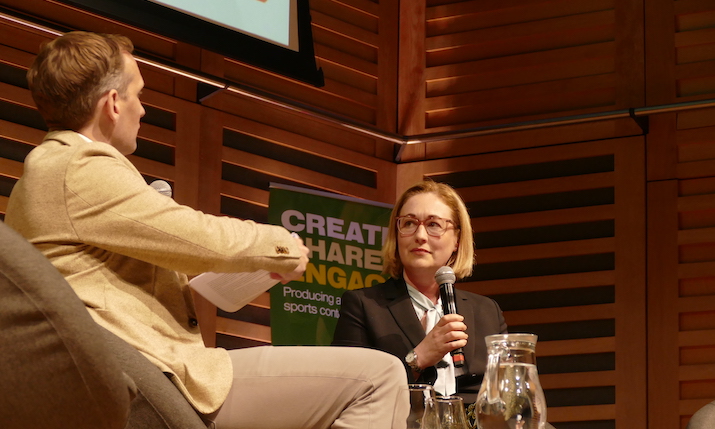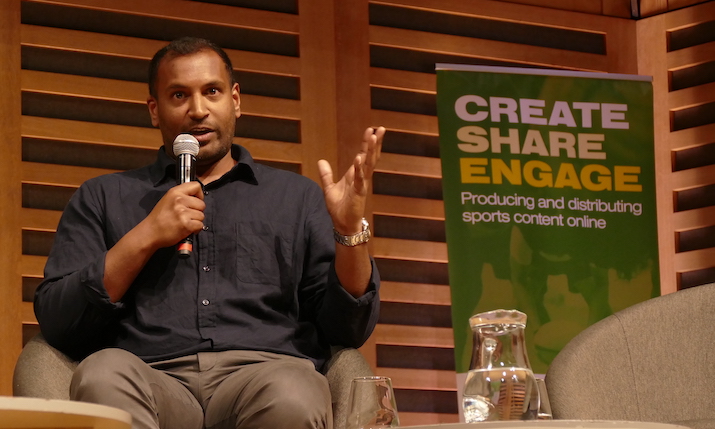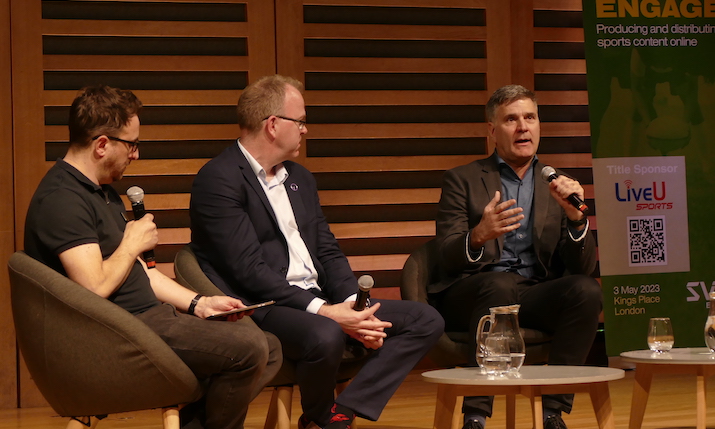Create Share Engage: Authenticity, creative storytelling and targeted content dominate the discussions

Melissa Lawton, chief content officer at SailGP, speaks to SVG Europe’s George Bevir
Bringing together those at the forefront of creating and monetising new and engaging viewing opportunities and experiences within sports, SVG Europe’s Create Share Engage event (Wednesday 3 May, London) delivered a whole host of insight into everything from content authenticity and ad etch in live sport to best practice when creating digital content for multiple platforms.
After an introduction from Steve Wind-Mozley, CMO at title sponsor LiveU, the inaugural event began with an opening keynote featuring FIBA Media managing director Andrew Ryan and Gauthier Rakotonirina, head of third-party marketing. The pair revealed how the international basketball federation captures and shares content to drive engagement among viewers and create commercial opportunities.
Delivering relevant and local content is central to the success of FIBA’s approach. “We really do try to invest in the creation and development of content assets for each specific country, so you’ll have high-quality content assets made available to our broadcaster in the US just as much as you will our broadcaster in smaller countries such as South Sudan, and it’ll be content that is useful to them, not just generic content which won’t gain a huge amount of traction in their market,” said Ryan.
“Our production philosophy is to put the viewer not just in the best seat in the house, but the best seat anywhere,” he added.
This will be helped at the upcoming Men’s Basketball World Cup, which starts in August, by the potential addition of a vertical drop camera, which is currently being trialled. “The plan is to drop it down just before tip off to make viewers feel like they’re almost in the circle. The camera will then rise so you get the feel of the athletes jumping,” Ryan revealed.
Rakotonirina went on to explain how utilising athletes’ social media reach is also helping FIBA to expand its appeal. “We have to think about what athletes want on their channels while also giving value to rightsholders. Within a game we produce a huge amount of content that we share with athletes.”
“The priority is to get those viewers to the live broadcasts. Seeing moments is one thing, but seeing the entire game is the full experience,” he added.
Continuing with the content creation theme, Sunset+Vine head of digital Raj Mannick shared his thoughts on how to produce effective sports content for digital platforms.
He said: “The best sports content is anything that reminds fans why they love sport. Any content that can capture that ‘hairs on the back of the neck’ feeling will be popular, along with content that shows the dedication and sacrifice of athletes. But that’s the extreme and there’s everything in between so there’s lots of opportunities.”

Sunset+Vine head of digital Raj Mannick
The key, he said, is not just to deliver content that is authentic, but that is also relevant to the platform, as what works on Facebook won’t perform so well on TikTok, for example. An added challenge is that measures of success are often changeable.
“Success is constantly evolving because this is a space that moves quickly. Revenue is obviously a key one, but engagement rate, for us, is a big, big measure of success. I think previously lots of people looked at views or reach, but the way that’s measured isn’t consistent across platforms, whereas with engagement rate someone has to physically interact with your content and that means you’re communicating with them.”
While the sheer number of platforms and the frequent changes they implement may seem daunting, Mannick concluded by saying: “As long as you’re not putting all your eggs in one basket – I think that’s a sensible approach to take. I also think if at the core you have your own values and principles and follow them, that’s the only way you’re going to build long-term trust with your audience.”
Melissa Lawton, chief content officer at SailGP, picked up on the issue of authenticity in a session entitled Racing Ahead with SailGP. “You’ve got to be yourself on each platform and each one of those platforms is looking for a slightly different version of you,” she expanded.
SailGP has a seven-platform strategy encompassing broadcast, OTT and social media. “We deliver content to the Facebook audience in a way that makes sense on Facebook. We have a YouTube channel, but within YouTube now there’s also those different levels – so the subscribers or core fans, the casual fans who are discovering us for the first time, and then there’s curious fans who come to us through new initiatives like shorts. TikTok is key for us to engage an audience that probably wouldn’t turn on the TV to watch us.”
The main aim of SailGP’s digital content strategy is to raise awareness. “We’re a start-up league, we’re in our third season and we want to be on as many platforms in as many formats as possible and in front of the largest audience possible.”
Data is already providing key information on the type of content that works, how much viewers are engaging, when they drop off and what doesn’t work, and this has led to changes in SailGP’s strategy. While initially broadcasts focused on in-depth informative content, “now we know people like to see boats on water, so we get to that action as quickly as possible”. For season 4, expect more content focused around the technology on board as this has proved popular. “It’ll be used in different formats across all platforms,” she revealed.
After a networking break, the audience at Kings Place in London were treated to an in-depth look at one of the 2023 IBC Accelerator projects – Create and Produce Anywhere. The project will focus on software-defined production, particularly looking at bandwidth-constrained locations with the aim of detaching software from hardware and deploying a distributed computing architecture between ground and cloud, exploring the benefits, challenges and the sustainable potential of such an approach.
“Moving to software is where we want to shine the light,” said Jon Hale, project engineer at Warner Bros. Discovery, which is one of the project Champions, along with BBC, DAZN, Sky Sports, BT Media & Broadcast and TVU Networks. “We want to be in a world where we can move software around dynamically.”
Issues such as interoperability are expected to add to what is likely to be a challenging project. “One key interoperability challenge already is that some people are Windows and some are OS – that’s a basic challenge but I’m sure things will get more complicated. We’re under no illusion it’s a really, really complex, multi-year project.”
As Andrew Copp, lead technical operator at BBC Sport Scotland, explained, the project is very much in its early stages, but the goal is “to do a fully remote production with as little bandwidth as possible. It’ll open doors for us to cover events we wouldn’t normally be able to, bringing more content for the audience. And if we can do that sustainably and cost-effectively, that’s great.”
The final session of the day saw Craig Spence, chief brand and communications officer at the International Paralympic Committee (IPC), and Tim Stott, digital executive producer, Host Broadcast Services (HBS), discuss how digital media content and online platforms will be used to shine a light on the 2024 Summer Paralympics in Paris.
While Spence shared some key aims of the athlete-led content already being produced ahead of the Games, the most important, he said, is to communicate the transformational impact of the Paralympics. “We are the only sporting event that changes the lives of billions of people around the world. The Games change the lives of every athlete that takes part, it changes the attitude of those people who watch it on TV, but the Games also lead a massive transformation in the host country – we change laws, we see significant investment thanks to the Games.”
The focus in the run up to 2024 is very much on making the Paralympians the storytellers, with many filming their own content which HBS then pulls together and shares with broadcasters.
“We have authentic connections with athletes. For broadcasters it gets people to care a lot earlier and it lets the Paralympians tell their own story on their own terms,” said Stott.

(L-R): SVG Europe’s Will Strauss; Craig Spence, chief brand and communications officer at the International Paralympic Committee; Tim Stott, digital executive producer, Host Broadcast Services
While the objectives in terms of encouraging ticket sales and audience interaction are the same regardless of how and where content is produced, the IPC does very different things depending on the platform it’s being published on. “TikTok is where we take the biggest risks. Sport doesn’t always go right so we show it when things go wrong. TikTok has gone crazy,” said Spence.
The IPC currently has around 3 million followers on TikTok, around half that of the Olympics, but it has 40 million more engagements.
“Ultimately ticket sales and TV audiences are the key metrics by which we measure success. If you have a venue with no spectators, people will switch off,” he added.
For Stott and HBS, there’s one clear focus when it comes to content: “The only thing that counts is does your content get used by the broadcasters. We have the capacity to modify our output in real time based on what’s being used. Ultimately, our digital strategy is about authenticity and organic storytelling from the ground up.”
Other speakers on the day included Tom Blake, commercial director at Imagen, talking about the data explosion; and Benjamin Fabricius, head of product management, uniqFEED, Massimo Magrì, EU managing director and global head of football, Supponor, and Richard Craig-McFeely, worldwide sports evangelist, AWS, who discussed advances in ad tech for live sport. In addition, Gareth Capon, CEO, Grabyo, and David Candler, senior director customer solutions, Veritone, explored the various stages of the lifecycle of sports content.

